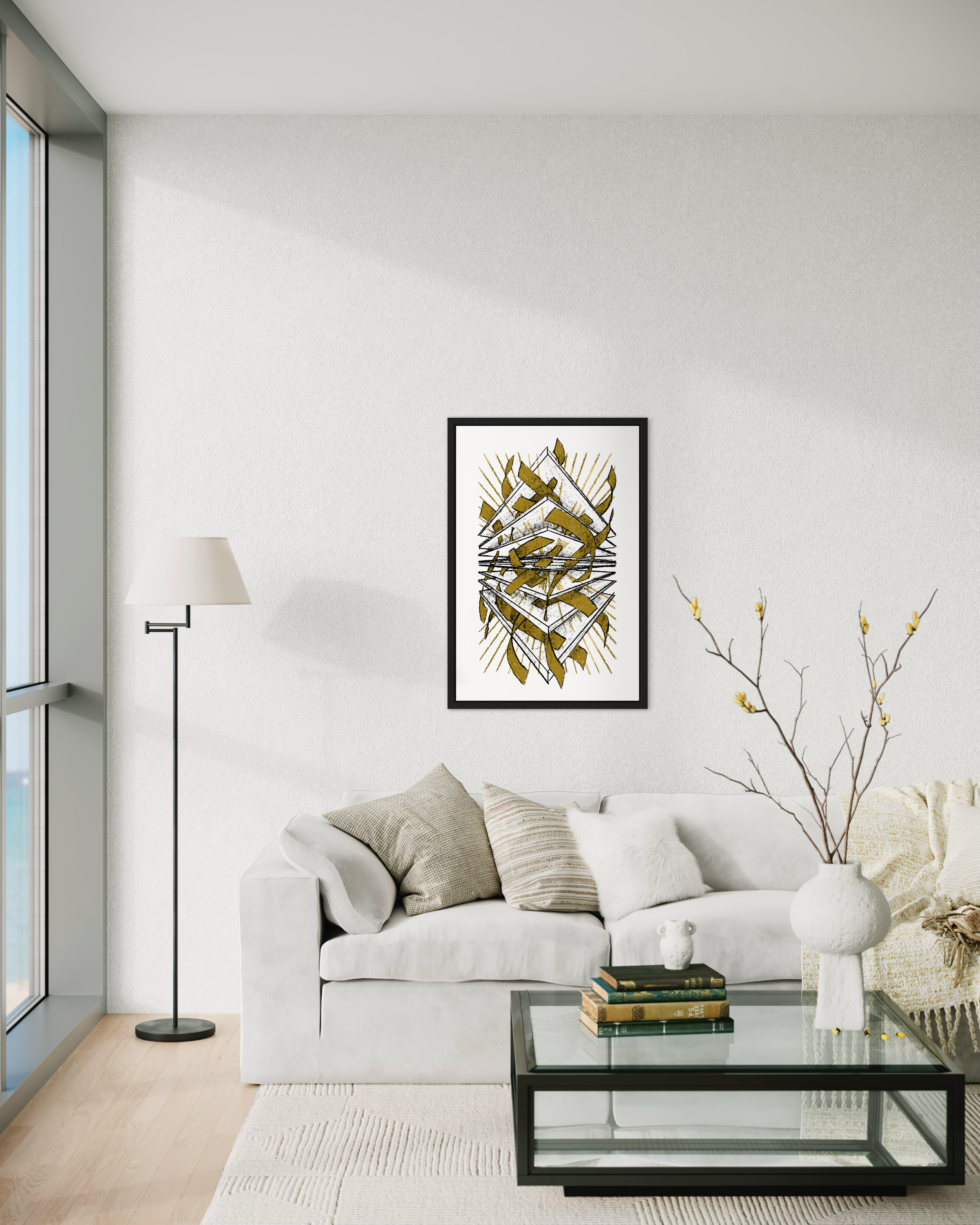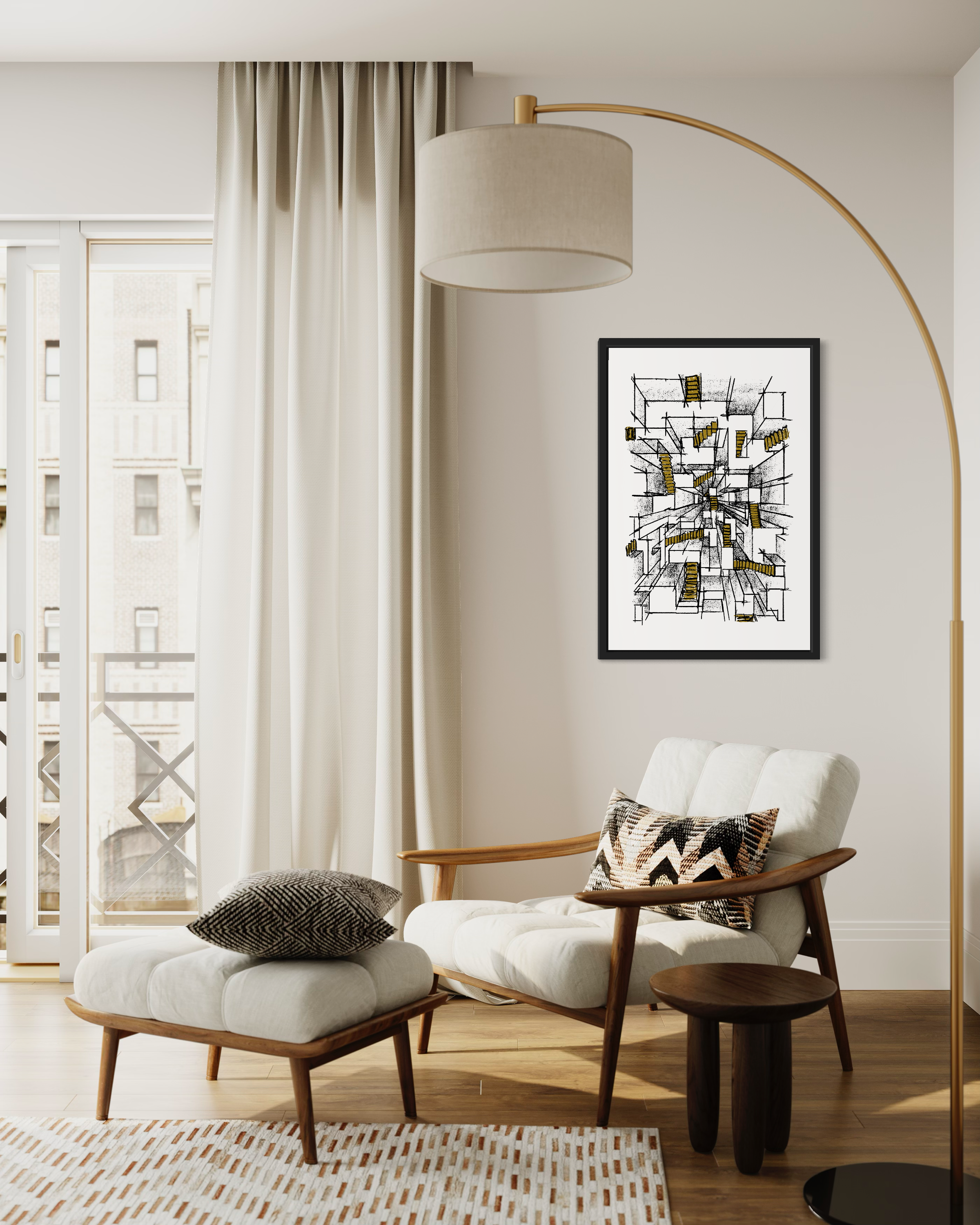Elevation Change
When my client came to me with her idea for a piece of artwork, and described it as “Chutes and Ladders meets engineering, but on a larger scale,” I embraced the challenge, and my brain started bursting with ideas. Having grown up with the iconic board game, I remembered exactly how exciting it was to move up the ladders and down the chutes, and I wanted to transmute that emotion into the artwork itself.
My first vision was a building going up and cranes and ladders were traversing unfinished floors, connecting the bottom of the structure to the top. With my engineering background, as well as my client’s, I felt pretty comfortable drawing the concrete floor slabs, scaffolding, cranes, and other construction components of the skeleton of an unfinished building, and I knew that she would understand and appreciate it.
As I drew this initial sketch out, I was only able to see it straight on. Then I began playing around with the perspective. The cranes and other construction equipment started forming, but it felt too sterile. Instead of drawing realistic versions of these things to represent the slides and ladders, I took a more abstract approach. I thought about the perspective of the floor slabs creating a 3-D feel, so I wanted to capture that with the chutes and ladders too. Like ribbons flowing from the top floor to the bottom, they cut right through the concrete slabs themselves.
Now more ideas started forming in my head of what the second idea could be. Instead of seeing the building straight on and disappearing into the sides of the paper, I thought about the building from the top instead, vanishing completely in the center. Levels of rooms and doors descending into the paper, but appearing to go deeper into the building itself. Playing with the elevation change provided by ladders and slides, I replaced these with staircases instead. The staircases going lower and lower into the building, deeper and deeper into the paper. As I was drawing this sketch, the art was drawing ME in.
These sketches turned out great, but it was the third one that really got me excited. I took another look at the game board, to get a little more inspiration. I had been visualizing the idea of the concept of the game in three dimensions, in the form of a vertical structure. But what about a horizontal structure instead?
As a civil engineer, a huge part of my job was to understand the way the surface of the earth changed in elevation so that we could direct the flow of rainwater away from the building and so a site didn’t flood. To design how we could control the flow of water, we manipulated our virtual surface in a process called grading. When I saw the up and down movements when you move your game piece around instead as water flowing up and down, a light bulb went off — I’ll grade the board game itself!
When I tell you that I was smiling the entire time I was creating a topographical version of Chutes and Ladders, I’m not exaggerating. I was just like a water droplet traveling up the ladders and down the slides. This was literally the perfect combination of art and engineering, and an idea I was SO excited to show my client, a fellow civil engineer who would appreciate such an idea, which she LOVED! We were both so happy.
Unfortunately without the context of having the game board laying underneath, it was a little tough to tell what you were looking at unless you knew that it was an inspired version of Chutes and Ladders but in a topographical format. Since I could not include the artwork from the board game into my own, we built off this winning sketch instead to come up with something that was in a similar vein but unique and harkened back to the board game as inspiration. At the time I was thinking about a new sketch, I was listening to a Tame Impala song and saw the album cover of his 2015 album ‘Currents.’
Another light bulb went off and playing with the idea of contour lines from a topographical map, I imagined a bunch of tightly stacked lines being moved up and down a board like liquid. From this idea, I came up with two versions of the final concept sketch — one with, and one without, empty squares just like a board game would have. When I presented the options to my client, she enjoyed both but was trying to find more meaning within the empty squares.
I’m not sure where this came from, but this was the meaning I gave to the art:
“In the game, you roll the dice and you may land on a spot that sends you up or sends you down. It’s completely up to chance, and you don’t know how far up the board, or how far down the board, you’ll go.
Now think about the art not as much as a board game, but representing life instead. If you look at the artwork, without any context added from the board game, you just see blank spots at the top and and bottom of each chute or ladder as ways to move around. In life, we roll the dice with every decision we make. We could move farther away from our goals and dreams moving down a chute or closer moving up a ladder!
The spots are blank because you will never know where the roll of the dice will take you. There’s no numbers on these blank squares because at any moment, you could land on one and you’ll never know which number square it is. There are an infinite amount of possibilities, and this is the adventure of life!”
Even I had a tough time choosing which option I liked better, and not only did this meaning win her over, I enjoyed it so much more too! We had our winning sketch, and I got to work. I lost track of time drawing it, but I can tell you that it was very fun to create. The title I gave this commissioned piece of artwork is ‘Elevation Change.’
If you enjoyed reading how I come up with ideas for my clients, and you loved the final result as much as we did, learn more about how you can get started on your own custom piece of artwork today!




